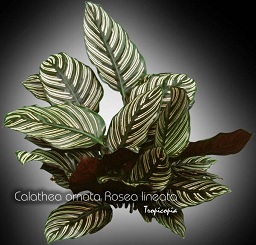Table of contents
Stiped calathea

Latin Name: Calathea ornata Rosea lineata
Category: Foliage plant
Family: Marantaceae
Origin: Cultivar
Climate: Tropical
Growing Zones: 11
Care Instructions
The Stiped calathea (Calathea ornata Rosea lineata) is a tropical plant that originates from Cultivar. This foliage plant plant belongs to the Marantaceae family and is well-suited for growing in USDA zones 11.
Complete Care Guide for Stiped Calathea (Calathea ornata Rosea lineata)
Watering Requirements
The Stiped Calathea, known for its striking foliage, thrives in consistently moist soil. It is essential to water your Calathea ornata regularly, ensuring that the top inch of soil remains damp but not soggy. Overwatering can lead to root rot, while underwatering can cause the leaves to curl and become crispy. A good rule of thumb is to water your plant once a week, adjusting based on the humidity levels in your home. During the growing season (spring and summer), you may need to increase the frequency of watering, while in the dormant months (fall and winter), you can reduce it slightly. Always use room temperature water, as cold water can shock the plant.
Light Conditions
Stiped Calathea prefers bright, indirect light. Direct sunlight can scorch its delicate leaves, leading to unsightly brown patches. Ideally, place your Calathea near a north or east-facing window where it can receive filtered light. If you notice the leaves losing their vibrant colors or becoming leggy, it may be a sign that it needs more light. Conversely, if the leaves start to fade or develop brown edges, it may be receiving too much direct sunlight. In low-light conditions, the plant can survive, but its growth may slow down, and the colors may not be as vivid.
Soil Preferences
The ideal soil for Stiped Calathea is a well-draining potting mix that retains moisture without becoming waterlogged. A blend of peat moss, perlite, and orchid bark works well, providing the necessary aeration and drainage. It is crucial to ensure that the pot has drainage holes to prevent excess water from accumulating at the bottom. Fertilization should be done during the growing season with a balanced, water-soluble fertilizer diluted to half strength every 4-6 weeks. Avoid fertilizing during the winter months when the plant is dormant, as this can lead to fertilizer burn and damage the roots.
Pests and Diseases
Common pests that may affect your Stiped Calathea include spider mites, aphids, and mealybugs. Regularly inspect the undersides of the leaves for any signs of infestation. If you notice pests, treat them promptly with insecticidal soap or neem oil, ensuring to cover all leaf surfaces. Additionally, Calatheas are susceptible to fungal diseases, particularly if overwatered or if humidity levels are too high. Signs of fungal issues include yellowing leaves and a musty smell. To prevent these problems, ensure good air circulation around the plant and avoid wetting the leaves when watering. If disease occurs, remove affected leaves and adjust your care routine accordingly.
Special Care Tips
To keep your Stiped Calathea healthy and thriving, consider the following special care tips: First, maintain high humidity levels, as Calatheas are native to tropical environments. You can achieve this by misting the leaves regularly, using a pebble tray filled with water, or placing a humidifier nearby. Additionally, avoid placing your Calathea near heating vents or air conditioning units, as sudden temperature changes can stress the plant. Regularly wipe the leaves with a damp cloth to remove dust and enhance photosynthesis. Lastly, consider repotting your Calathea every couple of years to refresh the soil and provide more space for growth. By following these care tips, you can enjoy the stunning beauty of your Stiped Calathea for years to come.








